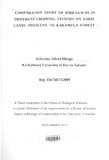| dc.description.abstract | Tropical rainforests are characterized by habitat stability and complexity. Hence, the forests
support a rich biological diversity, including 40% of all bird species. However, these rain
forests have been shrinking due to increasing rate of deforestation, fragmentation, and other
forms of resource exploitation. Degradation and loss of rainforests has threatened their rich
biological diversity and the life-support systems. However, the rate at which birds are
displaced by forest clearing and the potential for birds' conservation on farmlands are not
well understood. This study sought to establish the role of farmlands adjacent to tropical
rainforests in birds' conservation. The study was carried out for the period of seven months
(September 2010-March 2011) in small scale farms lying between two forests (Kakamega
main and Kisere) in Kakamega County, Kenya. The objectives were to determine the
cropping systems in farmlands adjacent to Kakamega forest determine the spatial and
temporal variability of birds' habitats in Kakamega, assess the relative abundance of birds
found in different cropping systems in the study area and to determine the variability in the
community structure of bird guilds in the study area. Information on crop cover types, crop
growth stages and estimates of percentage cover was obtained. Data on bird species
composition, diversity, richness and abundance in the identified habitats were collected
through timed species counts, conducted in a circular plots of 35m radius. Individual birds
were counted, identified and classified into feeding guilds. Their foraging sites were also
noted by crop cover and flight height levels present at the sampling sites. Sampling of birds
was done twice a week and crop growth stages were evaluated twice a month. Three major
habitat types (sugarcane farms without trees, sugarcane farms with trees and farms with
mixed crops) were identified. A total of 17,397 birds belonging to 126 species were found in
all habitats. Bird species richness was variable among the various cover types while species diversity remained relatively stable (Shannon diversity' H'=3.1 and H'=3.5). There was
difference (X2=6, df=5, p < 0.05) in number of birds in different bird guilds, insectivorous
having the highest number while the nectivorous contained the lowest number. Similarly, the
birds showed preference for top height level than the middle and the bottom levels (X2=3,
df=2, p < 0.05). Birds utilized various crop stages opportunistically and hence monthly
differences were not significant (dmax P > 0.05). Farmlands in the study area hosted a rich
community of birds, some of which utilized the adjacent tropical rainforest. It was also found
that farmlands provided refuge for displaced species and the presence of indigenous trees and
fruits appeared to offer favorable feeding and breeding opportunities. Bottom height level
was, however, unstable because of the manipulations by the land owners. Nevertheless, this
study showed that the mixed farming landscape in Kakamega offered ample potential for
birds' conservation provided that key habitats remain stable and are enriched with tree crops | en |

